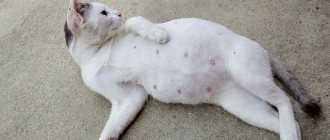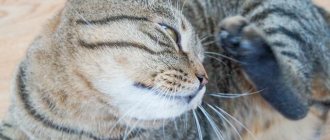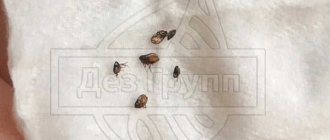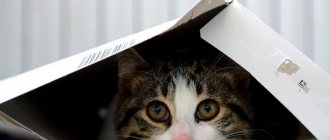Cramps or spasms (convulsions) are involuntary contractions of muscle fibers of individual or entire muscle groups. This condition is accompanied by sharp pain.
Seizures in a cat are not an independent disease, but only indicate the presence of serious pathological changes in the animal’s body. When muscle fiber spasms occur, the pet cannot move, shows aggression towards its owner, and screams in pain.
Even if seizures occur that do not manifest themselves in the future, it is necessary to contact a veterinary clinic for advice. This is due to the fact that seizures in cats are not a variant of the physiological norm.
Representatives of the cat family have an unusually elastic ligamentous-muscular system, which allows them to adapt to even the most abrupt transitions from a relaxed state to an active one. Therefore, the cause of convulsions can only be pathologies of internal organs.
List and description of possible causes
It’s rare that owners bring their cat to the veterinarian complaining that it has black specks in its fur. Usually they complain of severe itching and non-healing wounds after severe scratching. If these and other symptoms are present, the following diseases should be excluded:
- Demodecosis. Contrary to the erroneous opinion of some veterinarians, this disease still affects cats, although much less frequently than dogs. Demodex (Demodex cati) is considered a habitual inhabitant of the skin and normally does not cause any pathological manifestations. His activity is always provoked by something. Usually these are recent diseases of the internal organs, the postoperative period, prolonged use of antibiotics or severe hormonal fluctuations. All this manifests itself in the appearance of black grains in the cat’s fur, which are not accompanied by itching. It is important! But demodicosis causes the appearance of large bald spots (in severe cases, even partial baldness), in place of which small black dots appear. There is also the concept of juvenile demodicosis, which occurs in kittens aged 2-6 months. It usually affects the chin and flexor limbs. In most cases, it goes away on its own without the use of any medications. It is noted that demodicosis occurs more often in decorative breeds (Scots, British, Sphynx, Siamese).
- Flea dermatitis. Another reason why a cat may have black spots under its fur. A distinctive feature is that the parasites themselves may not be on the animal, since one bite is enough to provoke an allergic reaction to the flea’s saliva. The pet begins to behave restlessly, scratching its ears or chin (most often).
- Food allergies. A common phenomenon among decorative breeds. The slightest disturbance in the diet can provoke a severe allergic reaction, which manifests itself in the appearance of black grains in the fur, flaking, redness and hair loss (in some cases in clumps). The allergen is determined by exclusion, but most often the owners have to solve the problem for life with the help of drugs against itching and inflammation.
- Fleas. A real nightmare for cats of all ages. Even if you don't see them on your pet, it doesn't mean that fleas aren't biting him. You can get infected from other animals (dogs) or through objects brought from the street (even the soles of your shoes can have parasites). There are many cases when fleas were brought home along with the grass that cats love to eat in the spring and summer. At first, you may notice that your pet begins to itch more than usual (most attention is paid to the face). Over time, you may notice the appearance of black grains of sand under the fur, which fall off the animal after each stroking or combing. Large bald patches begin to appear due to scratching. In these places, brown-black crusts form on the skin due to claw wounds. The most correct solution would be to immediately treat all animals that have access to each other with anti-parasite drugs. Drops on the withers of Stronghold and Frontline are excellent against fleas and ticks. Process 2 times a month. Much attention is paid to the disinfection of housing, which is carried out using Parastop.
- Bacterial damage. A common occurrence in animals predisposed to allergies. Constant itching leads to deep calculations through which infection enters. Wounds can fester and take a long time to heal. Using cytology, the pathogen is determined and effective anti-inflammatory drugs are selected. In severe cases, antibiotic therapy is used.
- Dermatophytosis. A fungal infection that affects the cat's fur and skin. Small black grains and redness can be found at the site of the lesion. As the process progresses, the affected area transforms into a weeping wound the size of an egg. Severe itching leads to deep scratching and the process spreading to other parts of the body. Most often, pets who have free access to the street and, accordingly, to stray animals suffer. To confirm the diagnosis, a deep pluck is taken from the lesion for microscopic examination. This area can also be illuminated under a Wood's lamp, which will show a bright green glow if there are fungal spores in the fur. Treatment is long, with the use of antifungal drugs in the form of tablets, ointments and shampoos. To avoid relapse, all places with which the infected animal comes into contact are thoroughly washed with water and bleach and chlorhexidine.
Causes of elevated temperature
- Stress. Long trips, change of scenery, unfamiliar people.
- Overheating. Leaving animals in a stuffy room or car runs the risk of overheating, since their heat transfer will be impaired.
- During sterilization or castration, temperature changes of no more than 1 degree occur. This happens because the cat’s body tries to protect itself from viruses. Contact your veterinarian if the situation persists.
- Inflammation. If wounds and sutures after operations are not properly treated, they become inflamed due to pathogenic bacteria. Care for stitches and wounds properly to prevent danger.
- Viruses. When infected, the pet’s body tries to protect itself from unfriendly viruses. The immune system protects against pathogens and increases heat generation.
Flea - appearance, structure, symptoms
Fleas are found everywhere. This is a fairly large order of insects, which includes subspecies that feed on cat, dog, rat and even human blood. They differ from each other in size, color of the chitinous cover and some features of the body structure.
What does a cat flea look like?
The cat flea is one of the most common and small species among the flea order. The size of an adult insect rarely exceeds 3 mm. For comparison, fleas that feed on human blood have body sizes of up to 5 mm, and moose fleas often reach a length of 12 cm! They move quite quickly on the animal’s body, as they are perfectly adapted for movement in thick fur. They have a body that is flattened laterally, allowing them to maneuver between hairs, and long hind legs, with the help of which fleas are able to make jumps up to half a meter long.
The color of a cat flea can vary from light red to dark brown. Sometimes there are almost black insects that are practically invisible in the fur of an animal with a dark color. Upon closer examination, one can discern light stripes on the abdomen that form at the joints of the abdomen. They become most noticeable when the insect is saturated, when its body increases in size.
What does a flea look like on a cat's body? Outwardly, they look like large grains of dirt stuck in the fur, and only at the moment of their movement it becomes clear that these are insects. A lot of deception is facilitated by flea excrement remaining on the skin of the animal, which is sometimes mistaken for insect eggs.
Flea larvae are not at all similar to adult insects. Outwardly, they look like legless and eyeless dark-colored worms with sparse bristles on the segments of their body. They are very small, no more than 6 mm in length and 1-2 mm in thickness. Unlike adult fleas, larvae do not feed on blood and live outside the animal’s body, in the folds of upholstery of upholstered furniture, carpet pile, and cracks in ceilings.
Flea eggs are small, white, about 0.5 mm long. Females lay them on the floor of the room, where they further develop to the larval stage. Flea eggs look like grains of semolina stuck to your finger:
Interesting fact! Fleas do not live on animals permanently. They only feed on their blood, but live on the floor of the room, in all sorts of cracks and in the upholstery of furniture.
Body structure
If you look at a flea from a close distance, you can see that its entire body is covered with numerous bristles and spines. They help the insect stay on the animal's body. The bristles are located over the entire surface of the body, on the limbs, back, and head. At the ends of the legs, 2 claws are also clearly visible; with their help, the flea moves in the thick undercoat. The hind legs are well developed and consist of 5 segments. The forelimbs are somewhat shorter, they do not participate in jumping and are mainly adapted for moving along the animal’s fur.
Female fleas are usually somewhat larger than males due to their voluminous abdomen, where they carry their eggs for the time being. In the back of the body in both sexes there is a peculiar tactile organ equipped with sensitive hairs.
Symptoms of fleas
- on the back;
- near the ears;
- in the armpit;
- on the skin in the chest and cervical area of the body.
Cats can seriously damage their skin when trying to get rid of insects. Microbes get into the wounds, which in some cases leads to inflammation of the skin and the development of all kinds of dermatitis.
If you suspect that there are fleas in the house, first check the animal's skin. As a rule, insect waste products can be found on it - black lumps of digested blood. When rubbed between your fingers, they break up into small particles. There are usually quite a lot of such traces left in the thick undercoat. In shorter and less dense hair there are fewer of them, since they are combed by the animal onto the floor, where they become food for flea larvae.
Interesting fact! After saturation, fleas jump off the animal and hide in floor cracks or other hard-to-reach places. The next “feeding” occurs no earlier than in a day.
Symptoms
After detecting acne, it is recommended to examine your pet for other abnormalities:
- bald spots - bald areas;
- swelling of the body, edema;
- hyperemia of the skin;
- pimples, the number of which increases over time.
Changed behavior is also a warning sign. If the animal is constantly itching, then black spots in the cat's fur are accompanied by itching on the neck.
Causes of fleas
- while walking in contact with an infected animal;
- through household items that have insect eggs and larvae on their surface;
- when adult insects are brought into the house on clothes or their larvae with dirt on shoes;
- from neighboring apartments where there are infected animals.
Do cat fleas bite people? A hungry flea attacks anyone who is nearby. There are no special restrictions in her diet, although she still prefers the blood of animals, and of a certain species. There is evidence that fleas attack people in the absence of their pets. Single bites can also be observed when the apartment is heavily infested with insects.
Fleas from cats are not transmitted to humans in the literal sense of the word. Insects only feed on animals and, accordingly, will not live on humans. However, they can migrate from place to place by jumping onto a person's clothing. This can happen if he walks near their habitat or pets an outdoor cat. Fleas can also move into the folds of clothing if a person picks up care items for an animal infested with insects.
Advice! To protect yourself from flea attacks, you need to carefully monitor the sanitary situation in your apartment - periodically wash the floor, wipe off dust, and wash dirty linen. It is in dust and piles of garbage that insects live and their larvae develop.
Skin diseases
As a rule, they are all infectious in nature and occur after a pet comes into contact with an infected object. Sometimes it is enough for a cat to go outside just once to pick up some kind of infection. Often, diseases such as pyodermatitis, cheyletiellosis, demodicosis, and scabies occur.
They are also caused by mites that parasitize the upper and deep layers of the skin. Severe itching in the first stages very quickly develops into general skin damage and baldness.
If a cat's skin problems are detected, the cat owner needs to thoroughly wash their hands with soap and maintain personal hygiene, since many viruses and bacteria can be transmitted to human hands.
[custom_ads_shortcode1]
Fighting methods
Animal processing
- shampoos
- sprays
- drops
- collars
- pills.
Anti-flea shampoos that contain an insecticide have proven themselves to be excellent. With their help, you can get rid of insects on an animal in one go. They are relatively safe for cats and last quite a long time after treatment. However, shampoos are not always convenient to use, especially if your pet is afraid of water. In this case, you can use flea spray.
Insecticidal preparations in the form of a spray are applied to the surface of the cat's skin, and certain protective measures must be taken to protect both the animal and the person carrying out the treatment. The face is covered with a gauze mask, and gloves are put on the hands. It is best to wear a special collar on your pet, designed to prevent the animal from licking the drug from its fur. You also need to cover the cat's eyes, nose and mouth.
Flea drops are applied to the animal's withers. This is perhaps one of the easiest to use products and is most popular among cat owners. It effectively rids the animal of fleas and at the same time is practically safe for the animal, since the toxic substance is applied to an area of the body inaccessible to the cat’s tongue.
Collars serve more as a preventative measure of protection, repelling insects from the animal while it walks around the yard. They are valid for a limited time and must be changed periodically.
The tablets are intended for internal use. They are given to the cat with food or simply placed on the root of the tongue and, stroking the throat, force it to swallow. As a rule, tablets can be used from 3 months of age, however, the condition of the animal must be taken into account and the dosage must be strictly observed so as not to harm its health.
Vaccination is a relatively new way to rid pets of fleas. It is quite effective and lasts for a long time after injection. However, this method cannot be used on pregnant or lactating cats, as the active substance may affect the growth and development of kittens.
Advice! When choosing a flea drop, you need to carefully study its composition and make sure that it does not contain pyrmethrin, since this insecticide is contraindicated for use on cats.
Treatment of a young animal
How to remove fleas from a kitten? The peculiarity of processing a young animal is that there is always a danger of poisoning it with an insecticidal preparation. Small kittens under the age of two months are breastfed by their mother and any external product applied to their fur will be immediately licked off by her and then passed into the body of the cubs with milk. Therefore, mechanical processing methods are mainly used:
- combing the fur with a fine comb;
- catching insects by hand;
- bathing with herbal decoctions.
There are also special shampoos for younger kittens, but they can be used on babies who have already been weaned from their mother.
From 2 months, provided that the kittens are separated from their mother, the following drugs are used:
- shampoos for kittens;
- flea powder;
- spray.
Shampoos are diluted in accordance with the instructions and applied to the pet’s coat. After a certain time, it is washed off, and dead insects are combed out with a comb. The powder is rubbed into the kitten's skin using your fingers, and care must be taken to ensure that the kitten does not lick the product from the surface of the fur. The spray is first applied to the palms and then distributed over the scalp. When processing, you need to exercise some caution and not bring your hands with the drug to your face.
Starting from 3 months of age, when treating kittens, you can use almost all drugs intended for adult animals.
Apartment pest control
- aerosols;
- powder preparations;
- means in the form of solutions.
Aerosols give very fast and effective results. It is enough to treat the room with them once and you can forget about fleas for a long time. However, this type of insecticide has the following disadvantages:
Powders act for a longer time, however, you have to wait longer for the results from them. Disinsection with their help will require long-term wet cleaning to wash away traces of the insecticide from surfaces. Powder preparations are scattered or sprayed indoors, trying to pay special attention to possible insect habitats:
- cracks in the floor;
- corners of rooms;
- the space behind the baseboards;
- floor surfaces under cabinets, beds, sofas.
Liquid products are diluted in accordance with the instructions and applied to places where insects accumulate using a sprayer. You can also simply wash the floor in your apartment with them. When processing, the following personal safety measures must be observed:
- put rubber gloves on your hands;
- cover your face with a protective mask;
- do not consume food or drinks during disinsection;
- remove food and personal items.
Treatment with liquid products gives a good long-term effect, but it is quite labor-intensive and will require a significant investment of time.
- pseudotuberculosis is an acute infectious disease that, despite the name, has nothing to do with pulmonary tuberculosis;
- tularemia is a bacterial infection that affects the lymph nodes;
- brucellosis is an infection that affects multiple organs and systems of the human body;
- Dipylidiasis - infection with tapeworms.
In addition, it can cause allergic dermatitis; the itching at the bite sites is quite strong and lasts for several days, during which a person is able to scratch the bite site until it bleeds, which, in turn, can lead to infection directly into the wound.
>How do insects get into an apartment?
Fleas are unpretentious in everyday life; they love humidity, dampness, and dark, dusty places in the house. They feed on the blood of humans and animals.
Features of treatment
The basis of treatment is systemic and local antifungal drugs. Today they are widely represented on the pharmaceutical market, but it is important to know that every year the level of resistance of Candida fungi to basic drugs increases. For example, resistance to drugs such as Fluconazole is almost complete. Previously, this remedy was used in almost all cases of the disease, but today doctors are forced to reconsider standard treatment regimens.
Treatment of oral thrush in adults is selected individually. The choice of systemic antifungal agent is based on the type of pathogen, the patient’s condition and the individual characteristics of his health. There are drugs to which the infection has minimal resistance. The doctor may prescribe drugs based on nystatin, imidazole derivatives, etc.
Additionally, local remedies must be used:
- solutions for rinsing the mouth;
- gels and suspensions for application to affected areas;
- local tablets and lozenges;
- Irrigation solutions and aerosols;
- ointments for placing in the oral cavity on a cotton-gauze swab, etc.
A specialist may prescribe pharmaceutical antiseptics or weak saline solutions for rinsing. Typically, solutions based on iodine, chlorhexidine, potassium permanganate, gentian violet, sodium tetraborate in glycerin are used. Your doctor may recommend placing some tablets in your cheek.
Effective means
Collars
But you need to remember that the effect of the collar is limited in time, and it must be changed approximately every 3-4 months.
Flea shampoos
An effective flea treatment can be purchased at a veterinary pharmacy. Before use, you should carefully read the instructions, since the concentration of toxic substances in shampoos may differ from each other, so it is important to follow the recommendations on the volume that must be used to treat animal hair.
Flea drops
Insecticides
It is better to purchase toxic flea products for treating your garden plot, basement and premises from the sanitary and epidemiological service. You can also order the treatment of a room or yard if for some reason you cannot do it yourself.
The product must be dissolved in water according to the instructions and thoroughly sprayed on the yard, garden plot or basement. Since poisons are often very toxic, take care to follow safety precautions: wear a respirator and gloves.
Sometimes pet owners are perplexed - they seem to have treated their pet’s fur, but after a while the animal begins to itch and bite fleas again. How so? The fact is that adult fleas live on animals, and they lay their eggs not only in the animal’s fur, but throughout the house:
- in crevices;
- behind the baseboard;
- in the pet's bedding;
- in carpets;
- in places where dust accumulates, etc.
The pests are very small, the length of an adult individual barely reaches three millimeters. Flea eggs are even smaller. They have a round shape and white color. Detecting flea eggs, photos of which can be seen in the article, is extremely difficult. But you need to know where the flea can lay them. Then the problem of how to destroy flea eggs is much easier to solve.
Allergy
If you regularly treat your cat's fur for parasites and the veterinarian's analysis does not show their presence, the cause of the itching may be an allergy. Pedigree cats and cats suffer from it especially often. This may be, like in humans, a manifestation of sensitivity to food, furniture upholstery, or some chemical component. A particularly clear sign of an allergy is when a cat licks itself heavily, thus trying to scratch its nose and lips.
Allergies can be not only to food components, but also seasonal or, for example, to dust and pollen. It is important to get tested and identify the irritating allergen as soon as possible.
[custom_ads_shortcode2]
White grains (microscopic balls)
White specks on cats' fur can only be noticed upon careful inspection.
One of the strange manifestations of cat malaise is white grains or microscopic balls that fall off the animal’s fur. They are not noticed immediately. At first, they only evoke puzzled glances from the owner and a silent question in his eyes. Where do the mysterious grains come from and what are they?
White grains are nothing more than flea eggs that have not yet hatched. They can get on the animal's skin and, accordingly, on the fur.
What to do and how to detect
If you notice a change in your pet's behavior, carefully examine him to see if he is bothered by fleas.
First of all, you shouldn't panic. In order not to bring the situation to critical limits, it is necessary to monitor the cat more often. This advice may seem very uninteresting and philistine, but this is the only way to notice changes in the health of your pet.
It is necessary to inspect your pet and the places where he recently sat more often. Flea eggs in the form of white grains will be especially noticeable on dark surfaces.
Having discovered uninvited guests, it is important to begin eliminating them as quickly as possible.
Prevention measures
- Limit your indoor cat's contact with street animals. At the same time, do not deprive her of fresh air: you can let your pet out onto the balcony or into a fenced-in space, for example, in the country.
- Timely treat your pet against external (fleas, ticks) and internal (helminths) parasites.
- Inspect the animal's fur and skin.
- Provide a balanced diet and avoid consuming foods that cause allergic reactions.
- Cats feel the manifestation of love and care from humans. You should not allow your pet to experience stress. Any worries and neuroses are the first step towards the development of diseases.
- Regular visits to the veterinary clinic .
[custom_ads_shortcode1]
Getting rid of the source of white grains
Bathe your cat only with special shampoos.
- Next, you need to treat the cat with flea drops, which are applied to the withers.
Flea drops for cats are very effective.
- The next step should be a flea collar.
Thanks to special impregnation, the collar repels fleas.
Many limit themselves to drops and ignore collars. Meanwhile, they represent a very powerful defense option. A classic flea collar is impregnated with a special substance that repels fleas. The action continues for 6 months.
Grains, i.e. Flea eggs appear after adult fleas have settled on the body; they lay their offspring.
Consolidate the result
You should pay attention not only to your pet’s hygiene, but also to the cleanliness of its bed or house.
After treating the cat, you should take care of the living space. There are probably eggs left in the apartment that have fallen from the cat’s fur. They can lie unnoticed for a long time until adults hatch from them.
All carpets, mattresses, soft furnishings and bedding should be thoroughly washed and vacuumed. This point should not be missed, otherwise all the cat’s treatment will be in vain.
In addition to the actions taken, a visit to the doctor would be useful. He will examine the animal's body and may find painful scratches on the skin from flea bites. You can do this yourself. But the specialist will give all the necessary recommendations.
Preventive measures
It is important to take action at the slightest suspicion of fleas in a cat.
And of course, it is necessary to have your cat examined at least several times a month. The fur needs to be spread apart so that the skin is visible. A healthy purr is always clean.
Features of diagnosing hair fungus
A specialist can determine the presence and type of fungus relatively easily and reliably with the help of laboratory tests using microscopic and cultural methods. The first involves taking hair and skin flakes from the patient to examine for the presence of mycelial spores, gas bubbles, and fragments of large mushrooms. The cultural method is used if the presence of a fungus is nevertheless detected and allows one to determine the specific type of mycelium that has colonized the patient’s scalp. To do this, the detected fungus is grown in a nutrient medium, after which the grown colony is examined, in particular, the growth pattern is assessed (the process takes several days).
One of the modern tools used to determine mycosis is a Wood's lamp. The device emits a wave of a certain length and allows you to illuminate the colonies, giving an idea of the size and location, but not providing an answer regarding the type of microorganism, and therefore the treatment tactics.
conclusions
A responsible owner always takes a short course of veterinary lectures without attending classes. Knowledge comes with experience caring for a pet. This is good, because an owner savvy with skills and theory will always be able to help a defenseless animal in a timely manner.
Unfortunately, in the early stages, some dangerous infections occur without obvious symptoms. Only with constant attention to the health and behavior of your pet can you recognize the presence of fleas, worms or worms in your pet.
Treatment:
- treating the affected areas with a weak solution of Citeal (with the permission of the veterinarian);
- applying Butox 50, Amitraz, Advocate or Stronghold;
- special formulations are recommended for the destruction of subcutaneous mites: Acaromectin, Cydem, Neostomazan, Ivermec;
- after removing crusts and partially cleansing problem areas, it is not solutions that are required, but preparations of a thicker consistency: ointments, liniments, gels. Effective products: Amidel-gel, Demos, Aversectin ointment.
Worms
Kinds:
Treatment:
Effective drugs for helminthiasis in cats:
- Alben S (tablets).
- Prazicide (suspension).
- Dironet (suspension).
- Drontal (tablets).
- Pyrantel (suspension).
Characteristic symptoms
The symptoms of a seizure caused by involuntary muscle contraction are quite pronounced, so it is difficult to miss them. The animal is frightened, feeling severe pain, begins to scream loudly, shows aggression, not allowing itself to be touched. During a convulsion, the pet’s pupils are dilated, the whiskers puff up, or, on the contrary, are pressed against the muzzle. Other signs of seizures in a cat include:
- salivation;
- secretion of foam from the oral cavity;
- involuntary act of defecation;
- uncontrolled urination;
- aggression;
- lack of response to the owner's calls.
What do flea larvae look like?
Flea larvae look like tiny white worms with a translucent body. Even if you look carefully, you cannot see their legs - they simply don’t exist. But the body of the larva is covered with sparse hairs, clearly visible under a magnifying glass or microscope.
The photo, enlarged several times, shows a flea larva:
In her body, the esophagus is clearly visible, filled with digestible food - various organic residues.
The maximum length of flea larvae that can be found in residential premises is 4-5 mm, the usual length is 2-3 mm. They can easily be confused with fly larvae that live in similar places, but the maggot is more mobile and does not have such transparent body coverings.
The flea larva has a fairly large head and 13 segments. Evolutionarily, the first three segments served to attach the legs, but gradually the limbs atrophied as unnecessary. Flea larvae have well-developed jaws of the scraping-gnawing type, allowing them to feed on fairly rough food.
The photo below shows flea eggs and larvae:
The smallest flea larvae, just emerging from the egg, have a small egg tooth on the crown of their head - a hard outgrowth that helps them break through the egg shell and emerge into the world. At the first molt, the tooth falls off along with the chitinous shell of the body.
In the photo there are large numbers of flea larvae in a rodent cage:
On a note
The development of the larva continues, depending on the availability of food and temperature conditions, from 9 days to several months.
Under optimal conditions - a temperature of about 23°C and an air humidity of 60%, the larvae develop in approximately three weeks. During this time, they molt three times, constantly grow and feed. At the last stage, the larva envelops itself in a thin silk cocoon and turns into a pupa.
At too high temperatures, flea larvae dry out - at low humidity this occurs already at 34-36°C. At high air humidity (up to 90%), growing juveniles experience this temperature quite normally.
Flea larvae can starve for quite a long time - up to 3-4 weeks. At the same time, they do not develop, do not grow, but also do not fall into suspended animation. The larvae have developed the so-called negative phototaxis - wherever they find themselves, they try to get into the least illuminated place. Although the eyes of flea larvae are practically undeveloped, they sense the presence of light well and try to hide from the illuminated place.
What is itching
One of the most common, most prominent and most annoying symptoms of skin diseases is itching. You need to understand what kind of phenomenon this is and what factors are responsible for its occurrence. Itching is a term used to describe an unpleasant sensation arising from the skin, leading to scratching and rubbing. This is one of the signs of skin diseases, which, however, can be accompanied by other infections.
If we talk about duration, we can highlight:
- Itching is acute (lasting less than six weeks),
- The itching is chronic (lasting more than six weeks).
Short-term itching is a defense mechanism (just like acute pain), indicating that “something is happening” in a given area of the skin. For example, as a result of an insect bite, cats begin to scratch the area to remove the parasite from its surface. Another thing is chronic itching. It may be accompanied by more serious medical conditions.
It is worth noting that the feeling of itching in cats can vary depending on the time of day, skin condition, body temperature or extreme stress. The threshold for the perception of itching decreases (which means the animal becomes more sensitive to irritants) in the following cases:
- At night. During this period, the influence of factors on the body decreases (for example, pain, touch, cold, heat), and therefore the need to itch disappears.
- At elevated skin temperature.
- With reduced skin hydration, dry skin itches more.
- With factors stimulating the mental state, in states of stress. Opioid peptides are then released, which can increase the itching sensation.
Some of the more common symptoms of itching in cats are:
- scratches,
- licking skin and fur,
- gnawing,
- chewing various parts of the body (for example, paws, tail),
- complete or partial hair loss,
- baldness,
- self-harm,
- dermatitis.
These animals are very reserved, which means it is very difficult to guess why the cat is constantly licking itself and scratching itself. Therefore, pay attention to the unusual behavior of your four-legged friend, such as:
- Rolling from side to side,
- Sounds that are more intense than usual
- Shaking your head
- Frequent demands for affection, with the itchiest areas of the body exposed.
If your cat has worms, read the article on how to get rid of them.
[custom_ads_shortcode1]
Where to look for flea larvae in an apartment or house?
Flea larvae usually stay where they have direct access to food and can be found in comfortable climatic conditions - in garbage, secluded warm places, in animal cages - in the toilet and under beds. In nature - in the nests and burrows of mammals and birds.
In apartments and houses, flea larvae should be looked for primarily in places where cats, dogs and other pets live and are kept, in heaps of garbage in pantries and closets, among stocks of old grocery products.
In garden plots, chicken coops and animal keeping areas, flea larvae live directly in the litter and dried droppings. It is under the layer of garbage and droppings in the same chicken coop that flea larvae sometimes swarm literally in the thousands.
However, you can also find flea larvae in completely unexpected places - in vases with flowers, under trash cans, in a box in which vegetables are stored. It is important to understand that they do not start here on their own, and you should look for them only when adult fleas were found in the apartment.
The photo below shows a flea larva under a microscope - you can easily correlate its size with the thickness of a cat's hair:
Means and methods for destroying flea larvae
Flea larvae should be destroyed indoors using the same means that are used against adult fleas:
- these can be as concentrates for dilution such as Executioner, Cucarachi or Tetrix, Raptor or Combat aerosols;
- as well as microencapsulated products such as Dana or Get (the latter has almost no odor);
- and even folk remedies - turpentine, kerosene, vinegar.
Traditional substances such as Dichlorvos or Karbofos are also effective against flea larvae, but in terms of safety and ease of use they are much inferior to modern drugs.
Dusts are also effective against flea larvae, but are practically useless against adult fleas. However, using powdered insecticides is somewhat more difficult, since they need to be scattered in places where the larvae are constantly located, which is sometimes problematic, and sometimes, when the larvae are found behind baseboards or under the floor, it is completely impossible.
In this case, it is very important that the dust itself is certainly near the larvae, since it only works when the pests eat it along with other food. Therefore, it turns out to be generally more difficult to deal with larvae than with adult fleas - even with aerosols, when fighting them, you need to treat places where it is very difficult to get close and where adult fleas themselves are not found.
Causes of swelling of the nasal mucosa
Swelling of the nasal mucosa during a runny nose can be caused by the following reasons:
- Infection
. Infectious rhinitis is often caused by viruses and is part of the manifestations of ARVI. In the absence of proper treatment or the presence of predisposing factors, bacteria join the viruses, and the inflammation becomes purulent. - Violation of vascular tone in the mucous membrane
. Because of this, their inadequate expansion or contraction occurs1. The problem most often provokes is the abuse of vasoconstrictor drugs. - Allergic reaction
. This refers to allergic rhinitis, which occurs during the flowering period of plants. Less often it is provoked by: dust, animal hair. - Traumatic injury
. Swelling occurs almost immediately after injury, and the timing of its disappearance varies from person to person4. - Adenoids
. Enlargement of the nasopharyngeal tonsil contributes to swelling and congestion in childhood1.
The cat is constantly dropping black dots. Treatment and prevention of fleas in cats
The eggs hatch into larvae, which spin cocoons and develop into pupae before developing into adults. Depending on environmental conditions such as temperature, humidity and the presence or absence of hosts, the cycle can take anywhere from several weeks to several months.
Cat flea larvae hatch from eggs that an adult female flea lays on its host, the cat. They do not remain on the body, but fall off when the cat moves. The animal stands up, stretches and shakes itself, and the flea eggs simply fly off into the environment.
Flea eggs look like translucent oval dots about 0.5 mm long. But it is quite difficult to see them, since they quickly dry out after being deposited, become heavier and fall out of the cat’s fur. The best place to look for flea eggs is in your cat's bedding and other places where your cat likes to sleep. If the cat is heavily infected, you can look with a magnifying glass at the base of the tail or on the stomach. If there is flea dirt in your cat's bedding, it likely contains flea eggs. Flea dirt is dark and the eggs in it have a whitish appearance.
Fleas survive by jumping on a host animal, burrowing into its skin and feeding on blood. In most cases they cause only mild itching, but in severe infestations, especially in kittens or older sick cats, they can cause severe anemia or even death of the cat. Fleas are also intermediate hosts of helminths. Some cats are hypersensitive to flea saliva. This causes severe itching and a local or general skin reaction.
A flea infestation can be identified by finding fleas on your cat or by seeing black and white flecks in the cat's fur, similar to grains of salt and pepper. These particles are flea feces (“pepper”) and their eggs (“salt”). Feces are formed from digested blood. If you comb them onto damp paper, they turn reddish-brown.
An adult flea is a small, dark brown insect, about 2.5 millimeters in size, that can be seen with the naked eye. Although fleas do not have wings and cannot fly, they have powerful hind legs that can be used to jump long distances. Fleas move quickly in fur and are difficult to catch.
Look for fleas on the cat's back and in the tail and back of the body. To do this, run a fine-toothed comb through the fur. Sometimes fleas are visible in the groin area, where it is warm and there is less fur. Itching is most severe in these areas.
How to give first aid
The main thing is not to panic. If a cat starts having convulsions, it looks scary; many furry owners fall into hysterics. Attacks happen suddenly, which means the first thing to do is remove sharp and potentially dangerous objects that the cat might touch.
© shutterstock
The next step is to take a blanket and wrap the cat up, but not too tightly. The warmth will make the cat feel better and this will protect the animal from unnecessary injuries. If you overdo it and squeeze the cramps, you can cause injury to your pet.
One solution could be massage, however, the effectiveness of this method is low . During cramps, the cramped limbs are massaged, and a heating pad is applied to the lower back. This will help reduce the amplitude of the spasm. But, as a rule, attacks in cats do not last long, so the owner simply does not have time to prepare anything.
The convulsions last about 2-3 minutes , after which the cat is in a comatose state for about 5 minutes. At this time, your pet needs care to avoid injuries and careless movements. In addition, affection will help calm a frightened pet.
If a cat has a seizure and severe convulsions begin, the use of drugs is strictly prohibited. On the Internet you can find recommendations about Valocordin and Corvalol. But for a pet, medication for treatment without a doctor’s prescription is a risk.
Calling a veterinarian is the best solution when your cat experiences spasms. But spasms and convulsions cannot be compared. Tremors can occur in cats after pregnancy or on the eve of childbirth, during “walking”. It is known that sterilized pets are less susceptible to such threats than non-neutered ones.
In adults, seizures are a clear indication of illness, which becomes natural and expected for an old cat. Older cats rarely die from injury or mutilation. In kittens, this may be a consequence of injury. Therefore, it is better not to delay in treating children. The kitten probably fell or hit itself while the owner was away, resulting in serious head damage.











